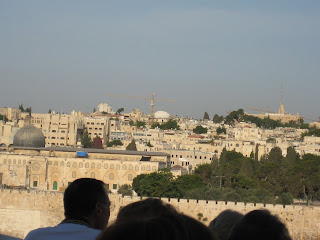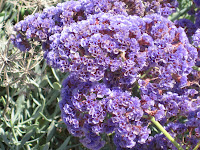
Back to the garden. Each group was assigned to a docent who escorts the
 group through the site. Ours was a young man who spoke perfect English and did an outstanding job of educating us about the Garden Tomb.
group through the site. Ours was a young man who spoke perfect English and did an outstanding job of educating us about the Garden Tomb.The main reason that this site is considered to be a strong possibility for the crucifixion and burial of Jesus Christ is the pattern on the side of a hill which has small "eyes" and the slit of a "mouth" that has the appearance of a skull (the meaning of Golgotha). The skull-looking hill we saw was adjacent to a road which is where the Romans chose to display the crucifixions as a warning and deterrent to potential "offenders". Now the hill overlooks a busy bus stop in an Arab section outside the city walls.
To the right is a shot of the hill which many believe to be Golgotha, or "The Skull".
Only steps from the hill is a tomb hewn from rock which again corresponds to the account of the burial in the Gospel of Matthew.
The Burial of Jesus (Matthew 27:57-61)
As evening approached, Joseph, a rich man from Arimathea who was one of Jesus' followers, went to Pilate and asked for Jesus' body. And Pilate issued an order to release it to him. Joseph took the body and wrapped it in a long linen cloth. He placed it in his own new tomb, which had been carved out of the rock. Then he rolled a great stone across the entrance as he left. Both Mary Magdalene and the other Mary were sitting nearby watching.
 to close the entry of the tomb.
to close the entry of the tomb.
Below is a closer view of the trough for the stone which is rolled (with great effort) over the opening of the tomb to seal the tomb.
The Empty Tomb Mark 16:2-5

Very early on the first day of the week, they came to the tomb when the sun had risen. They were saying to one another, "Who will roll away the stone for us from the entrance of the tomb?" Looking up, they saw that the stone had been rolled away, although it was extremely large. Entering the tomb, they saw a young man sitting at the right, wearing a white robe; and they were amazed.
As our docent so aptly pointed out, whether or not this is the exact site is not nearly as important as what was accomplished here or a place like this: The tomb was EMPTY! Jesus Christ rose from the dead and has conquered over sin and death. Again, whether it was here at this spot or somewhere nearby, the truth is that Jesus is not here or there...he is ALIVE and reigning from Heaven!
Concluding our visit was the celebration of the Lord's Supper led by our own group leaders. The wine/juice was served in an olive wood cup which we were able to retain as a keepsake. We prayed, sang songs and reflected as we gathered around the table to remember and thank Him for what He did for us.















































